Call me suspicious, but I am skeptical of anyone who claims to comprehend the inner workings of an absorption refrigerator. To fully fathom the depths of magic inside all those steel coils, you must understand thermodynamics, chemistry, fluid dynamics, and mechanics of materials. It’s an entire engineering education within a single appliance. Every time I think I understand it, another question pops up!
An absorption refrigerator is a miracle of engineering, no doubt. How does hot make cold? With no moving parts and only a simple boiler, the system can hold the temperature of a freezer compartment well below 0 degrees. The technology is well over 100 years old: invented in France, refined in Sweden (by two undergraduate students, no less), and imported to America. In a world where new smartphone updates come out every month, the good ol’ RV absorption refrigerator has soldiered on with hardly a technological hiccup since the 1960s.
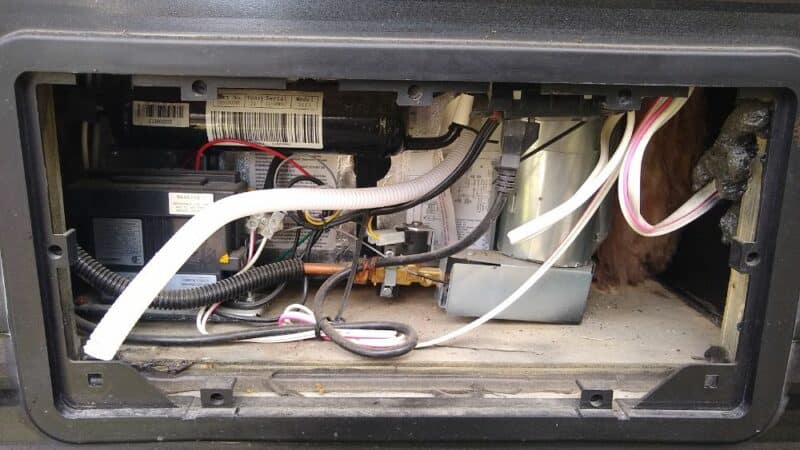
I Owe You (and Refrigerators) An Apology …
Can I confess something? A long time ago, when this blog was wide-eyed and innocent, I wrote an article somewhat optimistically titled “The Essential Guide to the RV Absorption Refrigerator.” Two years later, I re-read that article, and to my red-faced embarrassment, I completely screwed up the description of how an RV refrigerator works. Truth be told, I don’t think I really understood what I was describing. (Thankfully, blogging allows for editing.)
In this post, I won’t be making the same mistake. But as a reader, you have to understand that this post may not be easy to read. This is meat n’ potatoes stuff.
I’ve read a lot of blog posts purporting to describe how an RV refrigerator works. Most mindlessly parrot the same half-dozen points, and they leave a lot of questions unanswered. Many are also technically inaccurate. Here’s an example: One popular, trusted RV blog describes the first step of the cooling cycle as this: “Heat is supplied to a liquid refrigerant (typically ammonia & water), causing the mixture to boil and turn into a gas.”
That statement is technically incorrect. Ammonia is the refrigerant; water is the absorbent, which is a transfer medium. Plus, the entire mixture doesn’t necessarily boil. The boiling point of water at 300 psi is about 422 degrees; most of it doesn’t actually boil into a superheated vapor. Instead, ammonia vapor percolates out of the original strong (concentrated) ammonia-water liquid solution, leaving behind a weak (diluted) ammonia-water liquid solution.
We’ll get to all those technical terms in a minute. In the meantime, you may complain that I’m just another punctilious engineer splitting hairs. Maybe I am. But sloppy language like that blog post caused me no end of confusion and misconceptions. I finally hunted down some trustworthy answers after studying documents like forensic reports, research papers, and legal applications.
I still don’t claim to 100% understand absorption refrigerators. I’ve practically memorized the Wikipedia entry, but I still have so many questions, mostly involving the atomic physics behind Dalton’s Law. But I’ll take a crack at explaining how an RV ammonia-absorption refrigerator works. You’ll probably have to read more than just this article to truly understand the process; I’ve linked a lot of helpful resources in the text.
And I’ll share with you some words of wisdom I heard from Terry Lewis, one of my instructors at the NRVTA: “It doesn’t really matter.” You can operate and diagnose an absorption refrigerator without ever fully understanding what throttling is. And that’s OK. But if you’re curious like I am, it’s an itch you can’t help scratching.
My Ultimate Guide to the 3-Way RV Absorption Refrigerator
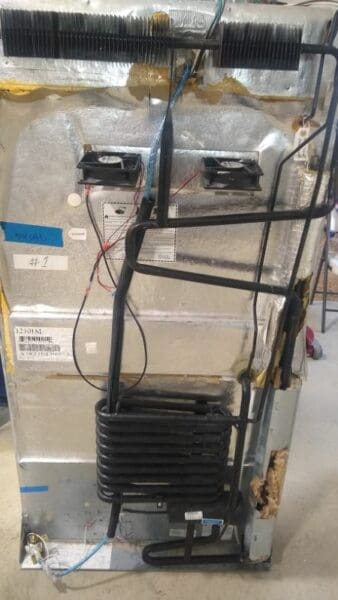
An RV absorption refrigerator is essentially a distillery. We use heat, evaporation, and condensation to get what we want. But instead of moonshine, we’re after cooling, better thought of as the transfer of heat.
Modern RV absorption refrigerators are sold as 2-way and 3-way refrigerators. 2-way refrigerators can run off 120-volt AC power and propane; 3-way refrigerators can also run off 12-volt DC power for a short time, usually while traveling. The primary purpose of the supplied power is to heat the boiler, which we’ll talk about later.
Theoretically, the system will operate just fine with no wires, no computers, no circuit boards. But then it’d be quite difficult to control the temperature, wouldn’t it? So the major manufacturers (Dometic and Norcold) use control boards and sensors to measure temperatures, start ignition, and monitor the system for safety. These control boards all run off 12-volt DC power, so your refrigerator won’t work unless you have a reliable DC power source, either your house batteries or a converter.
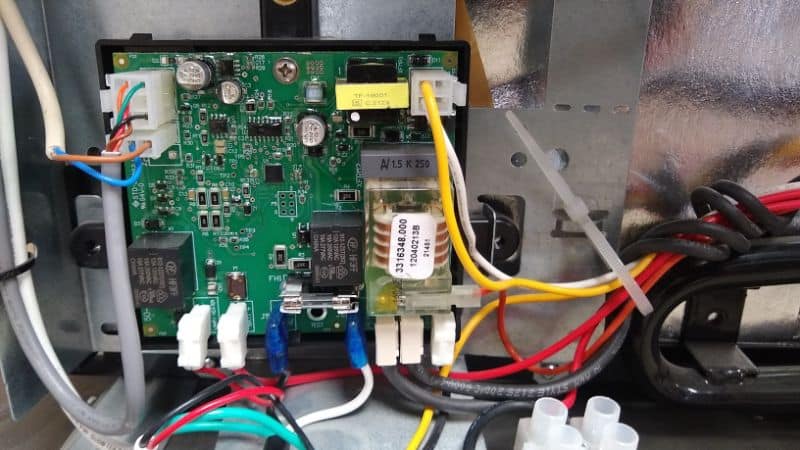
I will not be explaining the control logic in this article. That’s an entirely separate subject involving thermisters, thermal fuses, high-temperature limit switches, etc. You’ll need a multimeter to peer inside the electrical control system. This article isn’t about electrical troubleshooting; it’s just about understanding how the darn thing works.
How an RV Absorption Refrigeration System Works
So what’s happening inside the labyrinth of tubes on the business end of your refrigerator? Here’s a diagram courtesy of Dometic. I’ll be referring to quite a bit!
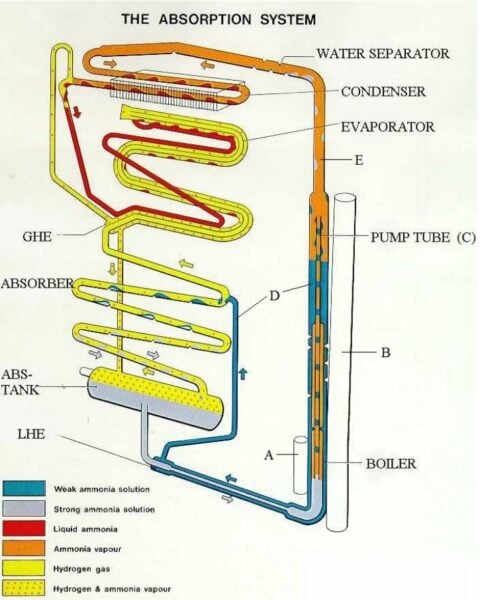
The Cast: Ammonia, Water, Hydrogen, and Sodium Chromate
There are four chemicals at work inside an RV absorption refrigeration system. No, you don’t need to balance a chemical equation to understand how an RV refrigerator works. Some of these components will dissolve in the others, but for the most part, they keep to themselves. Best to think of the process as a thermodynamic cycle, not a series of complex chemical reactions.
- Ammonia (NH3). This odorous gas is one of the world’s most reliable refrigerants. It boils at -28 degrees Fahrenheit, smells like cat urine, doesn’t contribute to greenhouse warming, and is reasonably safe for commercial use. It is the working refrigerant, the fluid responsible for heat transfer. It’s the lead actor, if you will.
- Water (H2O). Water is the absorbent. Its primary purpose is to absorb ammonia vapor from the hydrogen, thereby separating the two and allowing the cycle to start over. Water isn’t a refrigerant, but it is a necessary working fluid. It’s a transfer medium, a liquid that carries the refrigerant.
- Hydrogen (H2): Hydrogen is an inert gas that acts an an assistant gas. Its purpose is to lower the partial pressure of the ammonia vapor in the evaporator, which reduces its boiling point. An assistant gas is necessary in a single-pressure system, which is the kind made by Norcold and Dometic. Engineers smarter than me debate the pros and cons of using helium versus hydrogen gas, as they each have pros and cons.
- Sodium chromate (Na2CrO4): Sodium chromate is a rust inhibitor (yellowish, powdery) that prevents the steel tubing from corroding due to the water absorbent and ammonia refrigerant (fun fact: copper cannot be used with ammonia). The sodium chromate exists as dissolved sodium and chromate ions within liquid water, which create a protective, passive chromium oxide layer atop the exposed steel tubing. Sodium chromate is often downplayed as a minor actor, but it’s incredibly important. Dometic says that without sodium chromate, an absorption refrigerator wouldn’t last longer than a year. Magnetite crystals from the corroded steel would form complete blockages, like clots in an artery.
It might be helpful to realize no fluid circulates through every single tube. Some tubes will only ever contain hydrogen; some, only ammonia. Ammonia, in fact, is the only fluid that completes a complete cycle through all four major parts: evaporator, absorber, boiler, and condenser. Water only circulates between the absorber and the boiler plus rectifier; hydrogen only circulates between the absorber and the evaporator.
The Stages: Evaporator, Absorber, Boiler, Condensor
In order to understand how an RV refrigerator works through absorption, you need to understand that there are tubes within tubes. Inside the boiler, for instance, there is a pump/percolator tube inside the main shell, which doubles as the return tubing for the weak ammonia solution. Think of these nested Russian Doll tubes as two-lane highways, allowing fluids and vapors to occupy the same space but move in different directions.
Unfortunately, you can’t physically see all these components at once – not unless you’ve destroyed your refrigerator, that is! The evaporator section is invisible, hidden within the innards of the insulated refrigerator “catbox” itself. That’s why these diagrams are so useful.
Together, these components comprise the cooling unit. Even though it’s made of a single continuous set of steel tubes, the cooling unit is divided into several functional components. (It’s useful to remember that these components are named for the phase effect on the working refrigerant, which in our case is ammonia.)
- Evaporator: This is the “heart” of the system. It’s where the cooling happens. The evaporator is split into two sections: a low-temperature section for the freezer and a high-temperature section (albeit still cold) for the refrigerator. The refrigerant runs through the freezer section first and the refrigerator section second.
- Absorber: The absorber can be thought of as a “separator.” Its job is to absorb the warm ammonia vapors after the evaporator in a strong ammonia solution, ready to start the process all over again. A lot of people don’t realize that heat must be dissipated from the absorber coils as well, since the phase change of ammonia from vapor to liquid releases latent heat. If the solution doesn’t cool down, the water cannot absorb sufficient ammonia; maximum saturation and temperature are inversely related.
- Boiler: The boiler is the “heat engine.” Most RV refrigerators have two sources of heating: 120-volt AC heating elements and a propane-fired burner. The boiler supplies pure, hot ammonia gas to the condensor and replenishes the absorber with fresh weak ammonia solution, which is mostly water.
- Condensor: The condenser “scrubs” heat. Air rising along the back of the refrigerator from the stack effect cools the condenser fins through convective heat transfer. This allows the hot ammonia vapor from the boiler to condense into a saturated liquid-vapor mixture. By stepping down the sizes of the transfer tubes, the mixture is throttled to a subcooled liquid. Eventually, the saturated mixture fully condenses into liquid ammonia, ready for the main show in the evaporator.
The boiler and condenser form the regeneration section of the system. There are intermediary stages as well, like a dimpled rectifier/separator between the boiler and the condenser to capture any excess water, but these four parts set the stage for the action.
It’s important to realize that the boiler is a type of heat exchanger. Electric heating elements are inserted into steel pockets welded to the main tubes; the propane burner heats the boiler chamber itself, not the liquid. In severe failures where the boiler has overheated, electric heating elements have been known to overheat and weld themselves in place!
Also, it’s helpful to realize that all of these processes are occurring simultaneously. It’s a continuous-flow system. Just as one train car yanks another forward, each gas or liquid molecule pushes on its neighbors, hurrying the mixture along. This process should be silent. If you hear a gurgling or hissing sound, that’s a 95% positive diagnosis of a failed cooling unit.
The Physics: Pressure, Gravity, Heat, and Air
- Pressure: RV absorption refrigerators use a hermetically sealed, pressurized cooling unit. The tubing assembly is pressurized to approximately 300-375 psi. We’ll discuss why later, but for now, just understand that without high pressure, this system doesn’t work. Therefore, any leak, no matter how small, tolls the death bell for the cooling unit.
- Gravity: There are no pumps, no moving mechanical parts. The refrigeration cycle depends solely on gravity and fluid flow. This is why leveling your RV refrigerator is so critical! Leveling your refrigerator is as important as sloping a drain pipe; fluid can’t run uphill. Only being a few degrees off-level can cause a massive temperature rise in the boiler section, which can quickly lead to a permanent blockage from crystallized sodium chromate. Not good. But if you’re traveling with your refrigerator turned on, conventional wisdom says the “sloshing” from our bumpy, potholed US roads will (usually) prevent the boiler from overheating.
- Heat: Heat is the “engine” behind the absorption refrigeration cycle. Heat does two things: It separates the refrigerant from the absorbent, and it vaporizes the ammonia, which allows the gas to rise back to the condenser (heat rises, remember?). It’s like a little heat elevator!
- Airflow: Technically, airflow is caused by a difference in heat called the stack effect, but it’s easier to list it separately. RV absorption refrigerators do not work without airflow! These appliances make heat, and that heat needs to be transferred and exhausted to the ambient air. Otherwise, they overheat, and bad things happen. That’s why you have sidewall and/or roof vents behind your refrigerator; to form a chimney so that rising air can “scrub” heat off the absorber coils and the condenser fins. If the vents are blocked, or baffles are not correctly installed, or not enough air rises from the stack effect, then the performance of the refrigerator will suffer.
It’s hard to visualize all these elements at once, I know. Intuition only takes us so far in an environment of unimaginable pressure and heat!
The Thermodynamic Tricksters: Dalton’s Law and Latent Heat
Here’s the first fact you must know to understand how does an RV absorption refrigerator work: When most liquids evaporate, they absorb heat. You already know this intuitively; when sweat evaporates off your skin, you feel cooler. This is known as evaporative cooling.
You see, the liquid-to-gas phase change is endothermic, meaning that heat is required to complete the transition. This is because a gaseous vapor exists at a higher state of energy than a subcooled liquid, with more molecules zooming around and bumping into each other, ergo, greater kinetic energy. The first law of thermodynamics dictates that such energy cannot be created, only borrowed. Therefore, when a liquid vaporizes, it must absorb some heat from its surroundings. This property is called the latent heat of vaporization, and it’s the secret sauce behind modern refrigeration.
Here’s a helpful image from ByJus, the Learning App:

Here’s the second fact you must know: We can change the boiling temperature of a pure gas substance by changing its pressure.
Water, as you know, boils (vaporizes) at 212 degrees Fahrenheit – at least, it does so at standard pressure at sea level. But all mountaineers know that water boils at a lower temperature at higher elevations because of the lower atmospheric pressure. At the summit of Mt. Everest, water boils at just 154 degrees!
Ammonia, in contrast, has a normal boiling point at atmospheric pressure of -28 degrees. By adjusting the pressure up or down, we can adjust the boiling point (i.e. saturation temperature) up or down as well. In a mixture of (mostly) ideal inert gases, we can achieve the same effect by changing the relative partial pressure of the gas, not just the total pressure of the mixture. That’s called Dalton’s Law, and it’s a real mind-bender!
Now that we’ve learned about these two thermodynamic tricks, let’s see how they play out in an RV 3-way refrigerator.
>>> READ MORE: Pros and Cons of Absorption vs Compressor RV Refrigerators
How Does an RV Absorption Refrigerator Cooling Unit Work?
How does an RV absorption refrigerator work? Well, most people start by explaining the cycle at the boiler. I think it’s more intuitive to start at the evaporator because that’s where the magic happens.
Step 1: Cooling
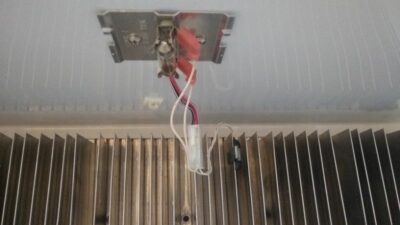
Boom! Warm, liquid ammonia flows through a small orifice into a larger hollow tube in the low-temperature evaporator. The evaporator is full of hydrogen gas at about 300-375 psi. Through the magic of thermodynamics (and the help of a little P-V expansion), the hydrogen gas lowers the partial pressure of the ammonia liquid to around 14 psi, which drastically reduces the saturation temperature. The ammonia starts to vaporize, absorbing a lot of heat along the way. This is the effect that cools your freezer and refrigerator. (If you peek inside your fridge, you’ll see fins (shown above) that increase the rate of heat transfer.) Anyway, the ammonia saturated mixture then continues through the high-temperature evaporator, which further cools your refrigerator compartment.
Step 2: Absorption
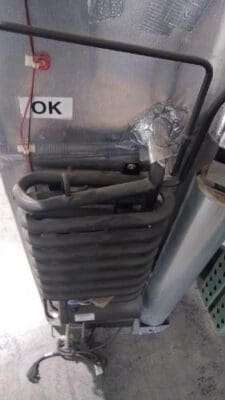
The refrigerant has done its job. Everything after this – the boiler, the absorber, the condenser, the rectifier, etc. – is all in pursuit of starting over. After exiting the evaporator, the ammonia-hydrogen gas mixture flows through a return tube into the absorber vessel, a large storage chamber. But there’s a coiled tube exiting the opposite side, so the ammonia-hydrogen gas mixture starts rising again through these coils. We don’t want that. But we’re clever engineers, and we know that cool water absorbs ammonia gas like a sponge. So we’ll use a trickle of weak ammonia-water solution to absorb the pure ammonia gas from the ammonia-hydrogen gas mixture as it’s slowly rising through the absorber coils. The resulting strong ammonia solution, a concentrated liquid, drains back down to the bottom of the absorption vessel, while the now-pure hydrogen gas happily rises back to the evaporator; its cycle is complete.
Step 3: Boiling
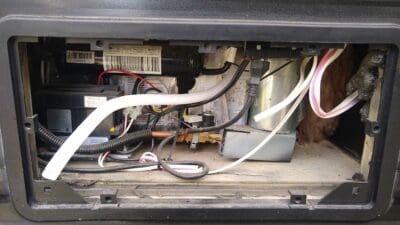
We now have a vessel of concentrated (strong) ammonia-water solution – but as you remember from Step 1, we need liquid ammonia to vaporize and extract heat. So how do we get the water out? That’s where the boiler comes in. The boiler has an inlet tube that connects to the bottom of the absorber vessel. It heats the aqueous strong ammonia solution, which causes most of the ammonia to vaporize and percolate out. The ammonia gas now rises through a thin percolator/siphon pump tube, carrying some water vapor and leftover weak ammonia-water solution along with it. With some clever nested tube design, we can get the dry, pure ammonia vapor to rise up, up, and away, while the water vapor and leftover weak ammonia-water solution condense back into a liquid and drain onto the top of the absorber coils (that’s where the water comes from in Step 2). Water’s cycle is now complete.
Step 4: Condensing
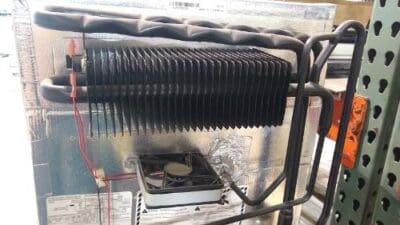
The ammonia vapor – remember, ammonia is the refrigerant we care about – is now a hot, dry, pure gas. But we need liquid ammonia to feed the evaporator. We need to dissipate some heat. So the ammonia gas passes through a heat exchanger with a series of finned tubes called the condenser. Ambient air picks up the excess heat. The cooled ammonia can condense back into a saturated or subcooled liquid – which is exactly what we need! Throttling the ammonia through some progressively smaller tubes further reduces the pressure, which further cools the liquid. And now, we’re back to Step 1. Fin!
Conclusion: My Brain?!
That’s about 3,000 words describing how an RV absorption refrigerator works. If you’re anything like me, you’ll have to read through my steps a half-dozen times, watch a few YouTube videos, read a few other articles, and revisit your thermodynamics textbook (no? Just me? Ok …) But eventually, I promise, you’ll get it! And if things are still mentally fuzzy, just remember the wise words of Terry: “It doesn’t really matter.” To some of us mental masochists, this is just our idea of fun.
Leave a Reply